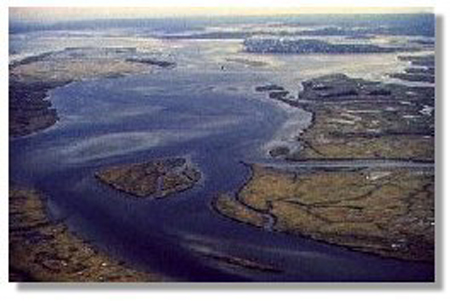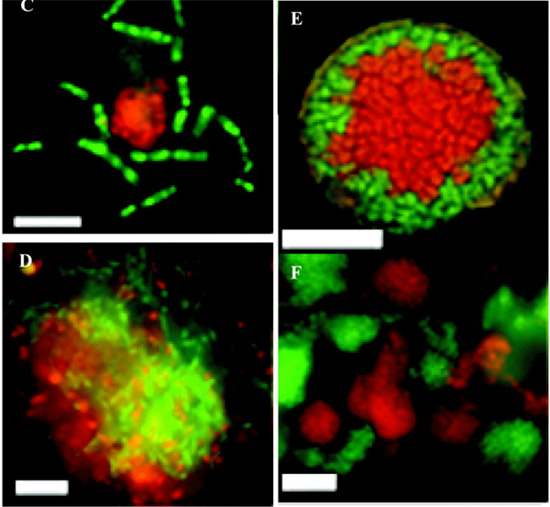Desulfosarcina
|
NCBI: |
Desulfosarcina. "(C) Color overlay of archaeal ANME-1 rods visualized with the ANME1-862 probe labeled with fluorescein (in green), and Desulfosarcina spp. stained with the DSS_658 probe labeled with Cy-3 (in red). (D) Large archaeal ANME-1/sulfate-reducing Desulfosarcina aggregate, showing an apparently random association of the two groups. Scale bar = 10 µ :m. (E) Color overlay of a layered ANME-2/DSS aggregate showing a core of ANME-2 Archaea (hybridized with EelMSMX932 probe), surrounded by sulfate-reducing Desulfosarcina (hybridized with DSS658 probe) imaged by laser scanning confocal microscopy. (F) Large aggregation of loosely associated, individual microcolonies of ANME-2 (EelMSMX932_cy3), and Desulfosarcina (DSS658_FITC)." Image & Information courtesy of Arches, specifically p.10 populations and methods.PDF here. |}
Classification
Higher order taxa:
|
|
|
Sulfate reducers have a wide range of cellular morphologies, including rods, vibrios, ovals, spheres and even tear-dropped or onion shaped cells. Some are motile, others are not. Most sulfate-reducing bacteria are mesophilic, but a few thermophiles are known. Desulfosarcina variabilis is mesophilic, and contains bacterial core lipids (see images on left). The dominant phospholipid headgroups in D. variabilis are Phosphoethanolamine PE (48%) and Phosphoglycerol PG (33%). One study has found that Desulfosarcina variabilis solely contained n-hexadecyl ether side chains. For more information on tetraether lipids found in Archaea, click here. |
Ecology
Although sulfate reduction is thought to be an anaerobic process, sulfate-reducing bacteria (SRB) are also important in aerobic environments if they can proliferate in anaerobic zones. For example, in marine sediments and in aerobic wastewater treatment systems, sulfate reduction accounts for up to 50% of the mineralization of organic matter. Furthermore, sulfate reduction strongly stimulates microbially enhanced corrosion of metals. {| width="100%"

The Plum Island Estuary Microbial Observatory (PIMO), located at the Plum Island Estuary LTER site in coastal Massachusetts, identifies prokaryotes in salt marsh sediments and plankton and determines their role in controlling major ecosystem processes. Among SRBs identified, relatives of Desulfosarcina variabilis and Desulfobacterium anilini were found to be persistent in the sediment.

